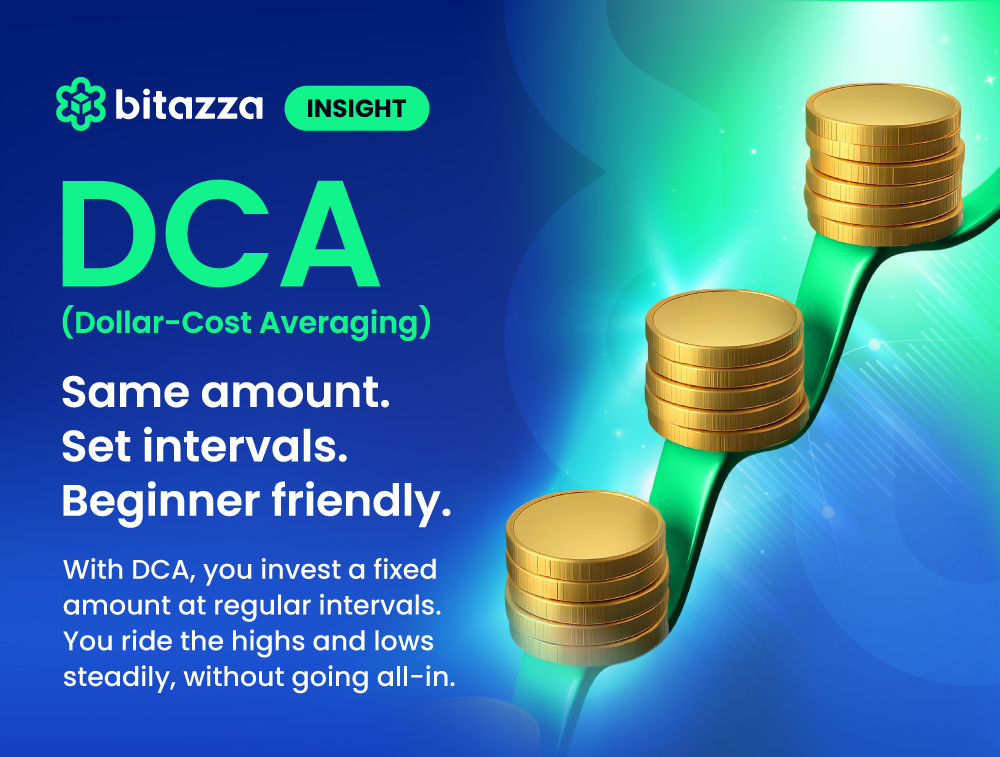Share this
What Is DCA? A Cost-Averaging Strategy Every Investor Should Know

In the world of investing, there are many strategies to manage risk and build long-term value. One of the most popular and beginner-friendly is Dollar-Cost Averaging (DCA). This simple but powerful approach helps reduce the impact of market volatility and encourages consistent investing habits.
What Is Dollar-Cost Averaging (DCA)?
DCA is an investment strategy where you divide your capital into equal amounts and invest at regular intervals—whether weekly, monthly, or quarterly—regardless of the asset’s price at that moment. This avoids the risk of investing a large lump sum during a market peak and spreads out your cost over time.
By buying more when prices are low and less when prices are high, DCA helps smooth out volatility and average your entry price. It also takes the emotion out of investing, helping you stay focused on long-term goals.
How to Apply DCA
Here’s how to get started with DCA on any asset, whether crypto, ETFs, or stocks.
1. Set a Fixed Investment Amount
Choose an amount you can commit to consistently without affecting your day-to-day expenses. For example, investing 10% of your monthly income is a good starting point. This prevents emotional over-investing during bull markets or panic-selling during corrections.
2. Choose Your Investment Frequency
DCA works whether you invest weekly, biweekly, monthly, or quarterly. More frequent intervals (like weekly) help smooth out volatility even more but may involve higher transaction costs. Many investors prefer monthly investing for its balance of cost efficiency and convenience.
3. Select Your Investment Asset
Choose assets that have strong long-term growth potential and align with your financial goals. These could include index funds, blue-chip stocks, or cryptocurrencies if you’re comfortable with the risk. Always research the fundamentals and market performance of the asset.
4. Review and Adjust Your Plan
DCA is a long-term strategy, but it still needs occasional tuning. Reassess your goals and financial situation every 6 to 12 months. You might increase your investment amount or rebalance your portfolio based on performance or life changes.
DCA in Action: A Crypto Example
Let’s say you decide to invest $100 into Bitcoin every month for one year, regardless of market conditions.
- You commit $100 per month
- On the same date each month, you purchase $100 worth of BTC
- Over 12 months, you invest $1,200 total
Some months you buy more BTC when prices are low, and less when prices are high. This helps you avoid trying to “time the market” and builds steady exposure over time.
Pros of Using DCA
- Builds investing discipline
- Reduces the emotional stress of market timing
- Spreads out entry risk during volatile periods
- Works well for investors without large lump sums
- Encourages long-term thinking
Potential Drawbacks of DCA
- May underperform lump-sum investing in a rising market
- Requires consistency and commitment
- Not ideal for short-term goals
- Doesn’t protect against poor asset selection
- May involve more transaction fees over time
DCA vs. Lump-Sum Investing
|
Aspect |
Dollar-Cost Averaging (DCA) |
Lump-Sum Investing |
|
Risk |
Lower short-term volatility |
Higher upfront exposure |
|
Convenience |
Requires discipline |
Simpler, one-time decision |
|
Returns |
May be lower in bull markets |
Can be higher if well-timed |
|
Best For |
Long-term investors, beginners |
Confident, risk-tolerant investors |
|
Capital Required |
Lower |
Higher upfront amount |
Choosing between DCA and lump-sum investing depends on your goals, time horizon, and risk tolerance. If you’re unsure about market timing or prefer gradual entry, DCA is a safer, more accessible option.
Tips to Maximize Your DCA Strategy
- Choose an amount that fits your cash flow
- Select assets with long-term growth potential
- Use automated DCA tools if available
- Review and rebalance your portfolio regularly
- Stay consistent, especially during market dips
FAQs
Who is DCA best for?
Anyone who wants to invest regularly, avoid emotional decision-making, and reduce timing risk. It’s especially helpful for beginners and long-term investors.
Why use DCA instead of a lump-sum investment?
It spreads risk across time and protects you from investing everything just before a market dip.
How often should I DCA?
It depends on your cash flow and transaction costs. Monthly DCA is a common, effective choice for most investors.
Conclusion
Dollar-Cost Averaging is a time-tested strategy that simplifies the investment process and encourages long-term financial growth. Whether you’re just starting out or looking to add structure to your investing routine, DCA helps you stay consistent, reduce volatility risk, and avoid emotional investing decisions.
Share this
- Crypto 101 (75)
- Trading (68)
- Crypto Weekly (48)
- Educational (43)
- Bitazza 101 (41)
- Featured (19)
- Missions (8)
- Market (6)
- Bitazza Insight (5)
- Research (5)
- Derivatives (4)
- TradingView (4)
- Education (3)
- Futures Trading (3)
- Freedom Shards (1)
- Freedom Token (FDM) (1)
- Intermediate (1)
- Product and features (1)
- Tether (1)
- Tether (USDt) (1)
- crypto exchange (1)
- December 2025 (13)
- November 2025 (6)
- October 2025 (10)
- September 2025 (8)
- August 2025 (17)
- July 2025 (29)
- June 2025 (13)
- May 2025 (14)
- April 2025 (12)
- March 2025 (8)
- February 2025 (8)
- January 2025 (8)
- December 2024 (7)
- November 2024 (5)
- October 2024 (14)
- September 2024 (9)
- August 2024 (14)
- July 2024 (3)
- June 2024 (48)
No Comments Yet
Let us know what you think